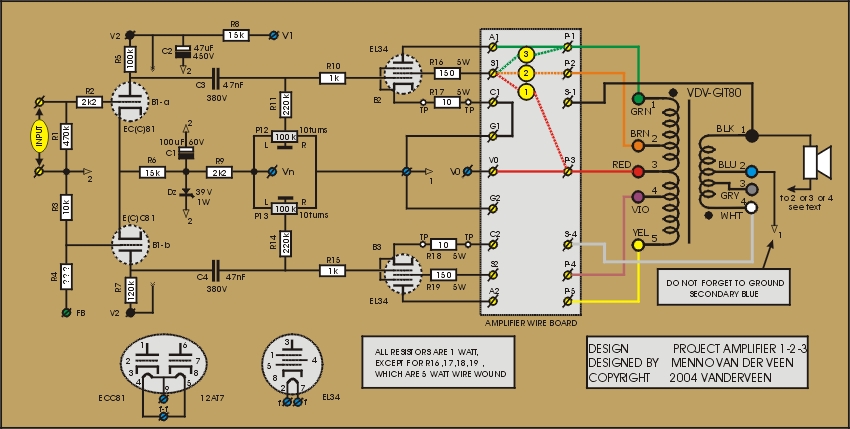I know that the expectations are high. Finally its time for Single Ended amplifiers. How disappointed will you be, hearing from me that amplifiers 1 to 3 are NOT good, the output transformer is in heavy saturation. In spite of this, these amplifiers teach us several important things. We can look inside the core of the OPT and we can hear the special silky sound of single ended amplifiers. See for more details the schematics below and the specifications in form-1-2-3 (click ![]() here).
here).
The lower power tube B3 is not connected, only the upper B2 does the job. By means of trimmer P12 the quiescent current is set at 50 mA in each amp. The impedance of the upper primary halve of the OPT equals 2 kOhm when a 4 Ohm speaker is connected between sec-1 and sec-2. Later these impedances and quiescent current can be improved. But as said, the amps contain a serious flaw. So, optimization is not for now.
The quiescent current of B2 through the upper primary halve is not compensated. Consequently the ungapped core of the OPT is in heavy saturation. All magnetic particles are oriented along the DC magnetic flux density vector, and they hardly can rotate with the music. This is equal to a very small relative magnetic permeability and results in a very small primary inductance Lp. The measurements directly show this, because the lowest -3dB frequency is around 50 Hz. This f-3L frequency is determined by Lp and Zp, where Zp is the primary impedance (2000 Ohm) and B2's plate resistance ri in parallel. This relation is given by: f-3L = Zp / ( 2 π Lp ).
Lets see what this formula teaches us with amplifier 1. There the secondary output impedance Z-out equals 45 Ohm. The plate resistance of B2 is given by: ri = 45 . 2000 / 4 = 22.5 kOhm. Then Zp is 2 // 22.5 kOhm = 1837 Ohm. In amplifier 1 the lowest frequency f-3L = 57 Hz, resulting in Lp = 5.1 H. This indeed is a very small primary inductance. Its maximum value is around 1000 / 4 = 250 H (only half of the primary is used). This small 5.1 H clearly proves that the core is in heavy DC saturation. The same calculation can be performed with amplifiers 2 and 3. Because their plate resistances are smaller, the resulting f-3L is somewhat smaller as well. So, these amplifiers have no bass and the cure is already known: compensate the quiescent current by using B3 as a current source. I will deal with this later in amplifiers 4 to 9, where powerful base response is found.
The highest -3dB frequency can be calculated in the same way by using Lsp and Cip in combination with Zp. For this moment I will not go there.
As a 14 year old boy (I am 56 now), I built my first tube amp. It was a 2 x EL84 push pull amp, with great impressive tonal qualities, enough power to scare my parents, and more than enough power to make my first success on the stage with my jazz band. At home, I did a lot of tests with this amp, and one of them was to remove one EL84. Surprisingly the amp sounded much better, more music and warmth and purity. In those days I did not understand what happened and why I appreciated this sound character so much. Now I know better. In spite of little bass, these amps sound silky and very musical. My ears love this sound but my measurement equipment hates it. What a disaster, what a distortion, how can this ever sound so good? Next time I will continue this single ended discovery tour, but then I have solved the core saturation by means of current compensation. Then the bass joins in with an exciting tonal balance.
Next time: Good SE amplifiers 4-6.

